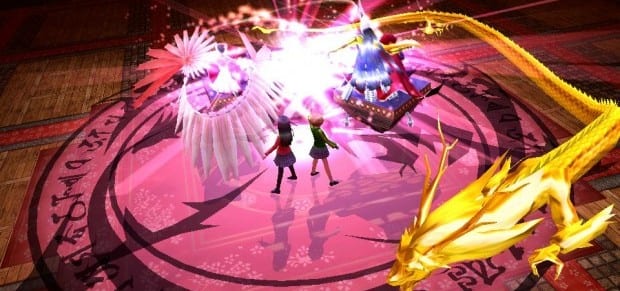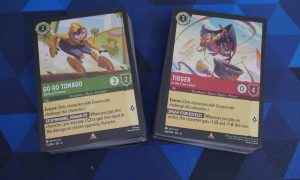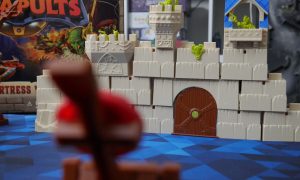
Atlus has a history of supporting the PSP with the original Persona series. The first two PS1 Persona games were enhanced with a better combat and negotiation system. Then Persona 3 Portable was released on the PSP. While the 3D travelling from the PS2 version was replaced with a fast travel system, the personality of all the characters and the gameplay was left intact. A female character was also included, changing the dynamic of the Social Links.
Now Persona 4 Golden has arrived on the PS Vita. The original Persona 4 was one of the last games released for the PS2, but it was a great one. While Atlus could have just repackaged the original game for the Vita, they took their time and added extra content to game so that those who played the original have reason to come back and revisit the world beyond the TV screen.
While Persona 4 sounds like it might fall within some of the typical RPG trappings, it offers a unique playing experience. Sure, you are an unnamed teenager moving into a new town where no one knows who you are, but instead of taking place in some apocalyptic wasteland or fantasy world, your kingdom is the modern day city of Inaba. You have a party where you fight enemies called Shadows, but you don’t crawl through dungeons to do it. Instead you dive into a TV and go through environments created by the psyches of different victims. While you and the members of your party gain experience, each member has a Persona that levels up as well. The Persona is a powerful manifestation inside each person that represents aspects of their psyche. Persona allow your party to manipulate elements and use abilities like healing or raising your party’s defense.
[singlepic id=8993 w=320 h=240 float=left]The story of Persona 4 revolves around several people who are found dead in Inaba after disappearing for several days. Rumors at school are about a Midnight Channel, where you can see strange things on the TV screen at exactly midnight on a stormy night. Eventually your character figures out that these people have been murdered by being pushed into the TV and are showing up on the Midnight Channel. Since you and your friends want to rescue a schoolmate, you venture through a TV in the local mall and enter a world with an odd-looking life size teddy bear thing named Teddie. From there the mystery of the murderer unravels as you save the different people thrown into the TV world.
The Personas are integral parts of the experience. Each teammate has their own Persona, and as they fight they gain experience that grants them new and more powerful abilities. You have the ability to use multiple Personas, and each one levels up as you use them. New Personas are gained by the “Shuffle Time” bonus game that happens sometimes after battle, or they are created in the Velvet Room through combining multiple Personas together. The enemies that you encounter have different strengths and weaknesses which you need to use to knock them down. Once they are all knocked down your party members can join in for an all-out attack on the enemies. This attack will damage them greatly if they aren’t completely destroyed. It also increases the possibility that a “Shuffle Time” bonus appears.
The Velvet Room is a location you can go to where you learn of the contract that allows you to use multiple Personas. Igor, the main inhabitant of the room, tells you of the catch where you must solve a mystery within a year. The calendar advances, but this mechanic is used to help you balance your social life and your leveling up through the TV world.
Persona 4 includes a meta game building relationships between you and other people called Social Links. The stronger the bond you have with others, the more powerful the Personas you can create are. These relationships can be with the guy on the basketball team, the shy band student, or the other members of the team. The Social Links might scare off some traditional RPG players, but it actually makes you more invested in the world because of the relationships grown. Maxing out the Social Links is the only way to create the most powerful Personas in the game.
Dealing with Social Links is a bit more manageable due to the fact you can go out in the evening. This gives you more options for building those Social Links. Certain Social Links are developed better during the evening. Before there wasn’t enough time in the day to max out all of the Social Links.
[singlepic id=8992 w=320 h=240 float=right]Those who don’t have patience should be warned Persona 4 starts off very slowly. Several hours will pass before you get into the meat of the game. Experienced RPG players should be used to it, but even then the beginning is tough to slog through. Once the ability to create Social Links and interact with the city is available, the world opens up and the game gets more interesting.
So what is unique about Person 4 Golden versus the original? First of all, the OLED screen really pops at you. It looks like most the character models have been updated, and the colors really pop on the OLED screen on the Vita. It definitely looks better than some of the recent HD upgrades that we have been given.
The amount of dialogue voice acted has increased by 50%. While it doesn’t seem like a huge deal, having the characters voiced more throughout the game makes you more invested in their story. Some of the music has been updated as well, with a new song in the rotation during combat.
[singlepic id=8991 w=320 h=240 float=left]One of the most interesting features is the fact that it uses the PlayStation Network to enhance the experience. During the game you can hit the Voice bubble. This lets you see what others have done during this point and time of the game. It doesn’t tell you what they have done is right, but it gives you some ideas that you might not have considered. Also, if you are in a dungeon, you can call for an SOS. If someone responds, you can gain back hit and skill points before the next battle. This is largely dependent on the number of users playing Persona 4 at that time, but there should hopefully be enough people who purchase the game to let others help you out.
In the original Persona 4, when you died in battle you had to start over at the last save point. Now you go back to just before your last battle when you die. This new feature is appreciated, especially after going up against a boss and finding out your party hasn’t leveled up high enough.
Marie is a new inhabitant of the Velvet Room who appears to have lost her memory. She is a new person to Persona 4 Golden whom you will be able to interact with and create a Social Link to. It’s not the most interesting storyline, but it doesn’t feel like it has been tacked on like some cheap DLC. She also has the ability to take skill cards and recreate them later. While this process can cost you a lot of money, it is another way for adding special abilities to newly created Personas.
One nice thing about the Vita is that you can put it into standby mode at any time. If you need to stop in the middle of the game, or even the middle of a battle, you just hit the power button. Hitting the PS button starts up the Vita and you start right where you left off. While it’s not the same as saving anywhere, being able to stop at any point is greatly appreciated. Just be careful that your Vita doesn’t run out of battery power.
Atlus has done such a good job with this version of Persona 4 that it truly deserves the “Golden” moniker. While I enjoyed the original PS2 version, the Vita version has so much added to it that it enhances the experience. It’s amazing how good the game looks on a portable. It is also easy to get over 100 hours throughout the game without being bored. I was thinking about this game even while I wasn’t Persona 4 Golden isn’t for everyone, but for those who do take the plunge, either for the first time or the first time on the Vita, it is well worth taking.
While not working as a Database Administrator, Keith Schleicher has been associated with Gaming Trend since 2003. While his love of video games started with the Telestar Alpha (a pong console with four different games), he trule started playing video games when he received the ill-fated TI-99/4A. While the Speech Synthesizer seemed to be the height of gaming, eventually a 286 AT computer running at 8/12 Hz and a CGA monitor would be his outlet for a while. Eventually he’d graduate to 386, 486, Pentium, and Athlon systems, building some of those systems while doing some hardware reviews and attending Comdex. With the release of the Dreamcast that started his conversion to the console world. Since then he has acquired an NES, SNES, PS2, PS3, PSP, GBA-SP, DS, Xbox, Xbox 360, Xbox One S, Gamecube, Wii, Switch, and Oculus Quest 2. While not playing video games he enjoys bowling, reading, playing board games, listening to music, and watching movies and TV. He originally hails from Wisconsin but is now living in Michigan with his wife and sons.

See below for our list of partners and affiliates:























